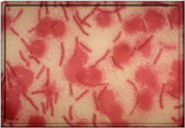
A gram stain of = bacillus anthracis
Anthrax is the = common name of the gram-positive, rod-shaped monera Bacillus anthracis and the = disease caused by an infection of those bacteria. Scientists believe that the fifth = Egyptian plague in 1500 B.C. was caused by an outbreak of anthrax, and it was also = responsible for the deaths of nearly all the cattle in Europe during the Middle Ages, so it is = most definitely not a new problem; however, in recent years, the threat of anthrax being = used as a biological weapon carried by missiles and other warheads has become a very real = one, causing anthrax to receive heightened scrutiny and research.

Anthrax bacteria
Livestock and wool mill workers = in third-world countries are most frequently afflicted by anthrax or = "woolsorters' disease," thanks to vaccination programs for carriers including cattle, sheep, = goats, and swine in most developed areas. Outbreaks are quite infrequent and = generally very localized. Neither insects nor vermin are important transmitters of the = disease. In humans, approximately 10,000 spores are needed to produce an = infection, but considering one trillion of the bacteria--measuring 1 x 3 microns--fit on the head = of a pin and there are 100,000,000 lethal doses to the gram, this is not as large a = number as it sounds. Because the bacilli are gram-positive, they infect their = victims by secreting a toxin into vulnerable tissues such as in the lungs. = They are also very hardy and can be deadly for decades under the right conditions. = There are three types of anthrax infections: cutaneous, spread by direct contact = between infected flesh and skin; gastrointestinal, from eating contaminated meat; and = inhalational, the most deadly type, initiated by spores in the lungs. Inhalational = anthrax is nearly always fatal to humans and treatment with antibiotics only brings the = survival rate to 20%. Luckily, only three cases of anthrax have been reported in the U.S. = over the past ten years, and all of them were cutaneous.

A cutaneous anthrax lesion
There are no immediate tipoffs = signifying an anthrax infection. No detectable tastes or odors have been linked to the = colorless powder. The incubation period may last from one to six days, after = which symptoms such as skin lesions (cutaneous), nausea and diarrhea (gastrointestinal), = low-grade fever, cough, and weakness (inhalational) appear. Diagnosing the disease may = be accomplished by analyzing samples of blood, necrotic lesions, or spinal fluid. = Patients frequently appear to improve two to four days into the course of the disease, but = by then the spores have moved to produce toxins in the lymph nodes and the victims = subsequently suffer respiratory distress followed by shock. In 20% of cutaneous, 60% = of gastrointestinal, and 99% of inhalational cases, death occurs, = frequently within three to five days of exhibiting the first symptoms. Louis Pasteur became the = first scientist to create a vaccine for anthrax in livestock in the late 1800's. An = FDA-approved series of six preventative injections made from a non-disease-causing strain = of anthrax has been available since the 1970's and is now routinely given to U.S. military = personnel. Intravenous penicillin, erythromycin, tetracycline, chloramphenical, = ciprofloxacin, and doxycycline can be effective at preventing fatality in infected = people, but only if administered before the first signs of infection appear and continued = until after a series of immunity-boosting vaccinations has been completed. Anthrax = infections are very seldom contagious in humans.
More information on anthrax can = be found at the following websites:
- The Official Dept. = of Defense Anthrax Information Web Site
- Anthrax= - General Information from the C.D.C.
- Information = Paper - Anthrax as a Biological Warfare Agent from the U.S. = military
- Anthrax as = Bio-War Agent; Treatment